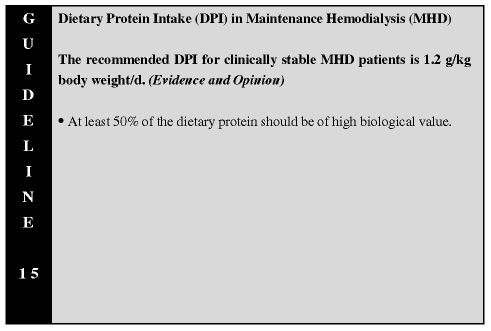
3. Management of Protein and Energy Intake

The findings from many studies that MHD patients have a high incidence of PEM underscores the importance of maintaining an adequate nutrient intake.128,129 Although there are numerous causes for malnutrition, decreased nutrient intake is probably the most important. Causes of poor nutrient intake include anorexia from uremia itself, the dialysis procedure, intercurrent illness, and acidemia. Inadequate intake is also caused by comorbid physical illnesses affecting gastrointestinal function, depression, other psychiatric illness, organic brain disease, or socioeconomic factors. Removal of amino acids (about 10 to 12 g per HD),130-132 some peptides,133 low amounts of protein (≤ 1 to 3 g per dialysis, including blood loss), and small quantities of glucose (about 12 to 25 g per dialysis if glucose-free dialysate is used) may contribute to PEM. Hypercatabolism from a chronic inflammatory state, associated illnesses, the dialysis procedure itself, or acidemia may also induce malnutrition.134-137
DPI is often reported to be low in MHD patients. A number of publications have described the mean DPI of individuals treated with MHD to vary from about 0.94 to 1.0 g protein/kg/d.57,138-140 Hence, approximately half of MHD patients ingest less than this quantity of protein. Few studies have directly assessed the dietary protein requirements for MHD patients. No prospective long-term clinical trials have been conducted in which patients are randomly allocated to different dietary protein levels and the effects of protein intake on morbidity, mortality, or quality of life have been assessed.
Several prospective nutritional-metabolic studies have compared the effects of different levels of DPI on nutritional status. Most of these latter studies have been carried out in in-hospital clinical research centers, and hence, the numbers of patients studied have been small.57,58,137,139 Taken together, these studies suggest that a DPI of about 1.2 g/kg/d is necessary to ensure neutral or positive nitrogen balance in most clinically stable MHD patients. At least 50% of the protein ingested should be of high biological value. Protein of high biological value has an amino acid composition that is similar to human protein, is likely to be an animal protein, and tends to be utilized more efficiently by humans to conserve body proteins. The increased efficiency of utilization of high biological value protein is particularly likely to be observed in individuals with low protein intakes.
Retrospective studies analyzing the relationships between DPI and such outcomes as nutritional status138 or morbidity and mortality have also been conducted.141-143 Protein intake in these studies has been estimated from dietary histories obtained from patient recall or estimated from the protein equivalent of total nitrogen appearance (PNA or PCR; see Appendix V for discussion of these methods). In two retrospective studies of MHD patients, protein intakes of less than 1.2 g/kg/d were associated with lower serum albumin levels and higher morbidity.140,141 On the other hand, not every epidemiological study found a significant relationship between morbidity or mortality and normalized PNA (nPNA or nPCR).142,143
In summary, a number of studies have shown a relationship between DPI and such measures of nutritional status as levels of serum albumin, prealbumin and transferrin, body weight, morbidity, and mortality. DPI also correlates with nitrogen balance. Protein intakes of less than 0.75 g/kg/d are inadequate for most MHD patients. Ingestion of 1.1 g of protein/kg/d (with at least 50% of the protein of high biological value) may maintain good protein nutrition in some MHD patients but is not sufficient to maintain good nutrition in the great majority of clinically stable patients ingesting 25 or 35 kcal/kg/d.58 It is therefore recommended that a safe DPI that will maintain protein balance in almost all clinically stable MHD patients is 1.2 g protein/kg BW/d; at least 50% of the protein should be of high biological value.
It is difficult for some MHD patients to maintain this level of daily protein intake. Techniques must be developed to ensure this level of intake for all patients. Education and dietary counseling should be the first steps in attempting to maintain adequate protein intake. If this approach is unsuccessful, nutritional support, such as that outlined in Guideline 19, should be considered. These techniques include food supplements, tube feeding, and intravenous nutrition. It should be recognized that foods containing protein are major sources of phosphorus, hydrogen ions, cholesterol (in the case of animal protein), and dietary fats. When increasing dietary protein intake, adjustments in therapy (eg, dialysis dose, phosphate binders, bicarbonate supplementation, and cholesterol management) should be considered.